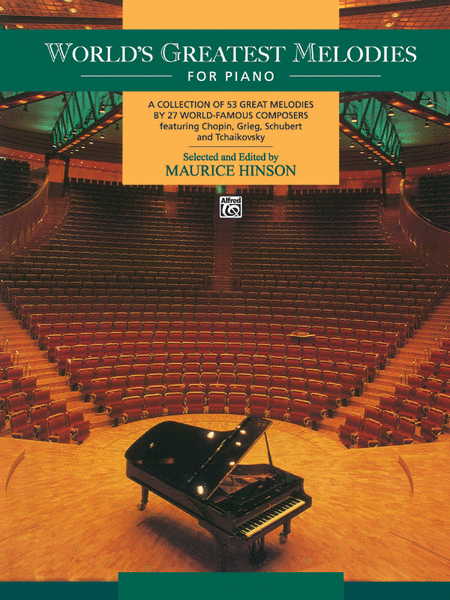World's Greatest Piano Melodies$19.99 - See more - Buy online Lead time before shipment : 1 to 2 weeks Format : Sheet music Keyboard (Masterworks Book). Level: Intermediate/Early Advanced (4/5/6/6 ). Published by Alfred Publishing. Instrumentation : Piano soloPublisher : Alfred PublishingLevel : 
Song List: Adagio Cantabile [Op. 13] Adagio Sostenuto [Op. 27, No. 2] Album Leaf [Op. 12, No. 7] Album Leaf [Op. 99, No. 4/1] Andante [K. 283] Arietta [Op. 12, No. 1] Chanson Triste [Op. 40, No. 2] Chant Sans Paroles [Op. 2, No. 3] Chopin [Op. 9, No. 13] Clair De Lune Concerto in B-Flat Minor [Op. 23] Concerto in C Minor [Op. 18] Consolation No. 3 [G. 172/3] Élégie Etude in C-Sharp Minor [Op. 2, No. 1] Etude in E Major [Op. 10, No. 3] Fantaisie-Impromptu [Op. 66] Four Small Piano Pieces, No. 4 [G. 192/4] Funeral March of a Marionette Gavotte German Dance [D. 783, No. 7] Hymn to Joy Jesu, Joy of Man's Desiring [BWV 147] La Fille aux cheveux de lin Largo May Song [Op. 1, No. 3] Menuet in G Major [Op. 14, No. 1] Moment Musical [Op. 94, No. 3] Nocturne in E-Flat Major [Op. 9, No. 2] Notturno [Op. 54, No. 4] On Wings of Song [Op. 34, No. 2] Passepied Poem [Op. 41, No. 4] Prelude in B Minor [Op. 28, No. 6] Prelude in C-Sharp Minor [Op. 3, No. 2] Prelude in E Major [Op. 11, No. 9] Reverie [Op. 39, No. 21] Romance [Op. 44] Salut d'Amour [Op. 12] Sarabande Song Without Words ("Venetian Gondola Song") [Op. 30, No. 6] Song Without Words [Op. 19, No. 4] The Beautiful Blue Danube Waltz [Op. 314] The Swan To a Water Lily [Op. 51, No. 6] To a Wild Rose [Op. 51, No. 1] Träumerei [Op. 15, No. 7] Valse Sentimentale [D. 779, No. 13] Vedrai, Carino Waltz [D. 145, No. 6] Waltz [Op. 12, No. 2] Waltz in A Major [Op. 39, No. 15] Waltz in E Major [Op. 39, No. 5]
|








